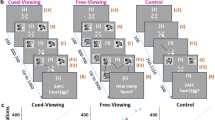Abstract
Objective
To assess visual acuity objectively “beyond V1”, the P300 event-related potential is a promising candidate and closely associated with conscious perception. However, the P300 can be willfully modulated, a disadvantage for objective visual acuity estimation. Faces are very salient stimuli and difficult to ignore. Here, we present a P300-type paradigm to assess visual acuity with faces.
Methods
Gray-scale portraits of the respective subject served as oddball stimuli (probability 1/7), scrambled versions of these as the standard stimuli (probability 6/7). Furthermore, stimuli were spatially high-pass filtered (at 0, 2.2, 4.2 and 8.3 cpd), making them recognizable only with sufficient acuity. Acuity was systematically reduced by dioptric blur, chosen individually to render faces unrecognizable when high-passed at ≥ 4.2 cpd. EEG was recorded from 11 subjects at 32 scalp positions and re-referenced to the average of TP9 and TP10. One of the rare face variants was designated as target, for which a button had to be pressed.
Results
The event-related potential was dominated by the P300 at 300–800 ms. All subjects had a significant (P < 0.05) P300 for 0- to 8.3-cpd filtering. When vision was blurred, the fraction of significant P300 responses to 8.3-cpd filtered faces dropped to 18 %, but stayed at 100 % for 4.2 cpd. Another component, the vertex positive potential (VPP) at 170 ms, was undetectable in most participants with blur and all levels of filtering, even when the images were recognizable.
Conclusions
The study demonstrates the feasibility of a face-based P300 approach to objectively assess visual acuity. The sensitivity to stimulus degradation was comparable to that of a grating-based approach as previously reported. An unexpected finding was the differing behavior of the P300 and the VPP. The VPP was quite sensitive to high-pass filtering, while the P300 sustained stronger filtering, although for its generation, the faces must also be discriminated from scrambled faces.






Similar content being viewed by others
References
Howard JE, Dorfman LJ (1986) Evoked potentials in hysteria and malingering. J Clin Neurophysiol 3:39–49
Villegas RB, Ilsen PF (2007) Functional vision loss: a diagnosis of exclusion. Optometry 78:523–533. doi:10.1016/j.optm.2007.04.098
Towle VL, Harter MR (1977) Objective determination of human visual acuity: pattern evoked potentials. Invest Ophthalmol Vis Sci 16:1073–1076
Teping C (1981) Determination of visual acuity by the visually evoked cortical potential (author’s transl). Klin Monbl Augenheilkd 179:169–172. doi:10.1055/s-2008-1057284
Odom JV, Hoyt CS, Marg E (1981) Effect of natural deprivation and unilateral eye patching on visual acuity of infants and children. Evoked potential measurements. Arch Ophthalmol 99:1412–1416
Röver J, Bach M (1987) Pattern electroretinogram plus visual evoked potential: a decisive test in patients suspected of malingering. Doc Ophthalmol 66:245–251
Nakamura A, Akio T, Matsuda E, Wakami Y (2001) Pattern visual evoked potentials in malingering. J Neuroophthalmol 21:42–45
McBain VA, Robson AG, Hogg CR, Holder GE (2007) Assessment of patients with suspected non-organic visual loss using pattern appearance visual evoked potentials. Graefes Arch Clin Exp Ophthalmol 245:502–510. doi:10.1007/s00417-006-0431-2
Bach M, Maurer JP, Wolf ME (2008) Visual evoked potential-based acuity assessment in normal vision, artificially degraded vision, and in patients. Br J Ophthalmol 92:396–403. doi:10.1136/bjo.2007.130245
Mackay AM, Bradnam MS, Hamilton R, Elliot AT, Dutton GN (2008) Real-time rapid acuity assessment using VEPs: development and validation of the step VEP technique. Invest Ophthalmol Vis Sci 49:438–441. doi:10.1167/iovs.06-0944
Almoqbel F, Leat SJ, Irving E (2008) The technique, validity and clinical use of the sweep VEP. Ophthalmic Physiol Opt 28:393–403. doi:10.1111/j.1475-1313.2008.00591.x
Di Russo F, Martinez A, Sereno MI, Pitzalis S, Hillyard SA (2002) Cortical sources of the early components of the visual evoked potential. Human Brain Mapp 15:95–111
Jiraskova N, Kuba M, Kremlacek J, Rozsival P (2011) Normal sensory and absent cognitive electrophysiological responses in functional visual loss following chemical eye burn. Doc Ophthalmol 123:51–57. doi:10.1007/s10633-011-9275-0
Sutton S, Braren M, Zubin J, John ER (1965) Evoked-potential correlates of stimulus uncertainty. Science 150:1187–1188
Linden DEJ (2005) The p300: where in the brain is it produced and what does it tell us? Neuroscientist 11:563–576. doi:10.1177/1073858405280524
Katayama J, Polich J (1999) Auditory and visual P300 topography from a 3 stimulus paradigm. Clin Neurophysiol 110:463–468
Picton TW (1992) The P300 wave of the human event-related potential. J Clin Neurophysiol 9:456–479
Duncan-Johnson CC, Donchin E (1977) On quantifying surprise: the variation of event-related potentials with subjective probability. Psychophysiology 14:456–467
Rosenfeld JP, Biroschak JR, Kleschen MJ, Smith KM (2005) Subjective and objective probability effects on P300 amplitude revisited. Psychophysiology 42:356–359. doi:10.1111/j.1469-8986.2005.00283.x
Gratton G, Bosco CM, Kramer AF, Coles MG, Wickens CD, Donchin E (1990) Event-related brain potentials as indices of information extraction and response priming. Electroencephalogr Clin Neurophysiol 75:419–432
Sangal B, Sangal JM (1996) Topography of auditory and visual P300 in normal adults. Clin Electroencephalogr 27:145–150
Fein G, Turetsky B (1989) P300 latency variability in normal elderly: effects of paradigm and measurement technique. Electroencephalogr Clin Neurophysiol 72:384–394
Ramachandran G, Porjesz B, Begleiter H, Litke A (1996) A simple auditory oddball task in young adult males at high risk for alcoholism. Alcohol Clin Exp Res 20:9–15
Barrett G, Neshige R, Shibasaki H (1987) Human auditory and somatosensory event-related potentials: effects of response condition and age. Electroencephalogr Clin Neurophysiol 66:409–419
Soltani M, Knight RT (2000) Neural origins of the P300. Crit Rev Neurobiol 14:199–224
Polich J (2003) Theoretical Overview of P3a and P3b. In: Polich J (ed) Detection of Change. Springer, US, pp 83–98
Polich J (2004) Neuropsychology of P3a and P3b: a theoretical overview. Brainwaves and mind: recent developments. Kjellberg, Wheaton, pp 15–29
Hansenne M (2000) Le potentiel évoqué cognitif P300 (I): aspects théorique et psychobiologique. Neurophysiol Clin 30:191–210
Polich J (2007) Updating P300: an integrative theory of P3a and P3b. Clin Neurophysiol 118:2128–2148. doi:10.1016/j.clinph.2007.04.019
Towle VL, Sutcliffe E, Sokol S (1985) Diagnosing functional visual deficits with the P300 component of the visual evoked potential. Arch Ophthalmol 103:47–50
Lorenz J, Kunze K, Bromm B (1998) Differentiation of conversive sensory loss and malingering by P300 in a modified oddball task. NeuroReport 9:187–191
Heinrich SP, Marhöfer D, Bach M (2010) “Cognitive” visual acuity estimation based on the event-related potential P300 component. Clin Neurophysiol 121:1464–1472. doi:10.1016/j.clinph.2010.03.030
Heinrich SP, Lüth I, Bach M (2015) Event-related potentials allow for optotype-based objective acuity estimation. Invest Ophthalmol Vis Sci 56:2184–2191. doi:10.1167/iovs.14-16228
Bargh JA (1982) Attention and automaticity in the processing of self-relevant information. J Personal Soc Psychol 43:425–436. doi:10.1037/0022-3514.43.3.425
Becker DE, Shapiro D (1980) Directing attention toward stimuli affects the P300 but not the orienting response. Psychophysiology 17:385–389. doi:10.1111/j.1469-8986.1980.tb00168.x
Heinze HJ, Luck SJ, Mangun GR, Hillyard SA (1990) Visual event-related potentials index focused attention within bilateral stimulus arrays. I. Evidence for early selection. Electroencephalogr Clin Neurophysiol 75:511–527
Polich J, Kok A (1995) Cognitive and biological determinants of P300: an integrative review. Biol Psychol 41:103–146
Polich J, Corey-Bloom J (2005) Alzheimer’s disease and P300: review and evaluation of task and modality. Curr Alzheimer Res 2:515–525
Saevarsson S, Kristjánsson Á, Bach M, Heinrich SP (2012) P300 in neglect. Clin Neurophysiol 123:496–506. doi:10.1016/j.clinph.2011.07.028
Rosenfeld JP, Soskins M, Bosh G, Ryan A (2004) Simple, effective countermeasures to P300-based tests of detection of concealed information. Psychophysiology 41:205–219
Marhöfer DJ, Bach M, Heinrich SP (2014) Faces are more attractive than motion: evidence from two simultaneous oddball paradigms. Doc Ophthalmol 128:201–209. doi:10.1007/s10633-014-9434-1
Changizi MA, Zhang Q, Shimojo S (2006) Bare skin, blood and the evolution of primate colour vision. Biol Lett 2:217–221. doi:10.1098/rsbl.2006.0440
Meijer EH, Smulders FTY, Merckelbach HLGJ, Wolf AG (2007) The P300 is sensitive to concealed face recognition. Int J Psychophysiol 66:231–237. doi:10.1016/j.ijpsycho.2007.08.001
Devue C, Brédart S (2008) Attention to self-referential stimuli: Can I ignore my own face? Acta Psychol 128:290–297. doi:10.1016/j.actpsy.2008.02.004
Tacikowski P, Nowicka A (2010) Allocation of attention to self-name and self-face: an ERP study. Biol Psychol 84:318–324. doi:10.1016/j.biopsycho.2010.03.009
World Medical Association (2000) Declaration of Helsinki: ethical principles for medical research involving human subjects. J Am Med Assoc 284:3043–3045
Heinrich SP, Bach M (2008) Signal and noise in P300 recordings to visual stimuli. Doc Ophthalmol 117:73–83. doi:10.1007/s10633-007-9107-4
Bex PJ, Makous W (2002) Spatial frequency, phase, and the contrast of natural images. J Opt Soc Am A Opt Image Sci Vis 19:1096–1106
Freeman RD, Thibos LN (1975) Visual evoked responses in humans with abnormal visual experience. J Physiol 247:711–724
Levi DM, Manny RE (1982) The pathophysiology of amblyopia: electrophysiological studies. Ann NY Acad Sci 388:243–263
Chan H, Odom JV, Coldren J, Dove C, Chao G-M (1986) Acuity estimated by visually evoked potentials is affected by scaling. Doc Ophthalmol 62:107–117. doi:10.1007/BF00140553
Bobak P, Khanna P, Goodwin J, Brigell M (1993) Pattern visual evoked potentials in cases of ambiguous acuity loss. Doc Ophthalmol 85:185–192. doi:10.1007/BF01371133
Bach M (1996) The Freiburg visual acuity test—automatic measurement of visual acuity. Optom Vis Sci 73:49–53
American Clinical Neurophysiology Society (2006) Guideline 5: guidelines for standard electrode position nomenclature. J Clin Neurophysiol 23:107–110
Katayama J, Polich J (1996) P300, probability, and the three-tone paradigm. Electroencephalogr Clin Neurophysiol 100:555–562
Efron B (1979) Bootstrap methods: another look at the Jackknife. Ann Stat 7:1–26. doi:10.1214/aos/1176344552
Webster MA, Georgeson MA, Webster SM (2002) Neural adjustments to image blur. Nat Neurosci 5:839–840. doi:10.1038/nn906
Heinrich TS, Bach M (2001) Contrast adaptation in human retina and cortex. Invest Ophthalmol Vis Sci 42:2721–2727
Woods RL, Colvin CR, Vera-Diaz FA, Peli E (2010) A relationship between tolerance of blur and personality. IOVS 51:6077–6082. doi:10.1167/iovs.09-5013
Wilkinson RT, Seales DM (1978) EEG event-related potentials and signal detection. Biol Psychol 7:13–28
Bonala B, Boutros NN, Jansen BH (2008) Target probability affects the likelihood that a P300 will be generated in response to a target stimulus, but not its amplitude. Psychophysiology 45:93–99. doi:10.1111/j.1469-8986.2007.00613.x
Teixeira M, Pires G, Raimundo M, Nascimento S, Almeida V, Castelo-Branco M (2014) Robust single trial identification of conscious percepts triggered by sensory events of variable saliency. PLoS ONE 9:e86201. doi:10.1371/journal.pone.0086201
Norcia AM, Tyler CW, Hamer RD, Wesemann W (1989) Measurement of spatial contrast sensitivity with the swept contrast VEP. Vis Res 29:627–637
Jeffreys DA (1989) A face-responsive potential recorded from the human scalp. Exp Brain Res 78:193–202. doi:10.1007/BF00230699
Bötzel K, Grüsser O-J (1989) Electric brain potentials evoked by pictures of faces and non-faces: a search for “face-specific” EEG-potentials. Exp Brain Res 77:349–360. doi:10.1007/BF00274992
Joyce C, Rossion B (2005) The face-sensitive N170 and VPP components manifest the same brain processes: the effect of reference electrode site. Clin Neurophysiol 116:2613–2631. doi:10.1016/j.clinph.2005.07.005
Yeom S-K, Fazli S, Müller K-R, Lee S-W (2014) An efficient ERP-based brain–computer interface using random set presentation and face familiarity. PLoS ONE 9:e111157. doi:10.1371/journal.pone.0111157
Barrera ME, Maurer D (1981) Recognition of mother’s photographed face by the three-month-old infant. Child Dev 52:714–716. doi:10.2307/1129196
Acknowledgments
This study was supported by the Deutsche Forschungsgemeinschaft (BA 877/18 and BA 877/21). We are grateful to our subjects for their participation.
Conflict of interest
All authors certify that they have no affiliations with or involvement in any organization or entity with any financial or non-financial interest in the subject matter or materials discussed in this manuscript.
Author information
Authors and Affiliations
Corresponding author
Electronic supplementary material
Below is the link to the electronic supplementary material.
Online Resource1
Target oddball stimuli spatially high-pass filtered with four different cutoff frequencies (0.0, 2.2, 4.2 and 8.3) (PDF 490 kb)
Rights and permissions
About this article
Cite this article
Marhöfer, D.J., Bach, M. & Heinrich, S.P. Objective measurement of visual resolution using the P300 to self-facial images. Doc Ophthalmol 131, 137–148 (2015). https://doi.org/10.1007/s10633-015-9502-1
Received:
Accepted:
Published:
Issue Date:
DOI: https://doi.org/10.1007/s10633-015-9502-1




